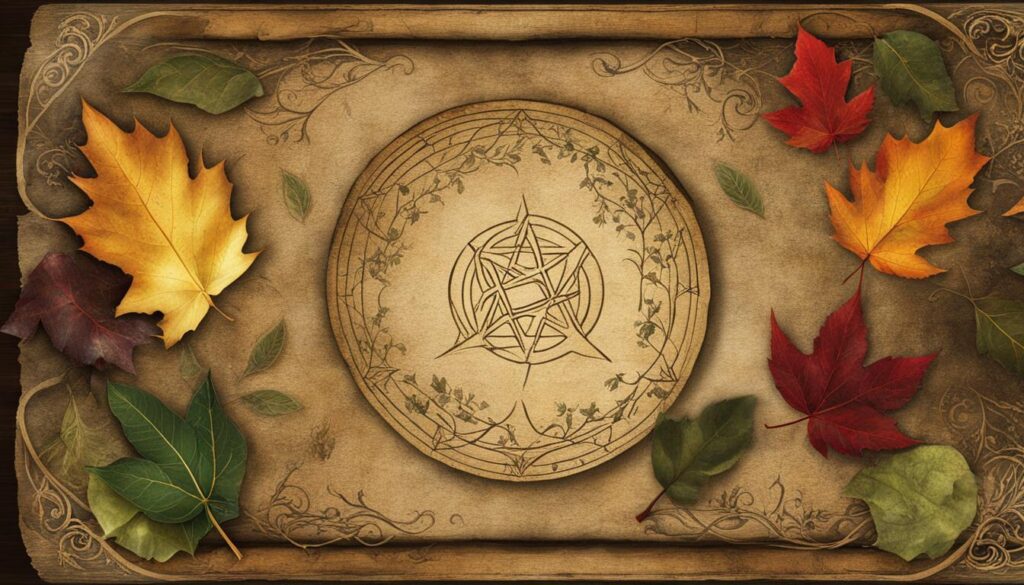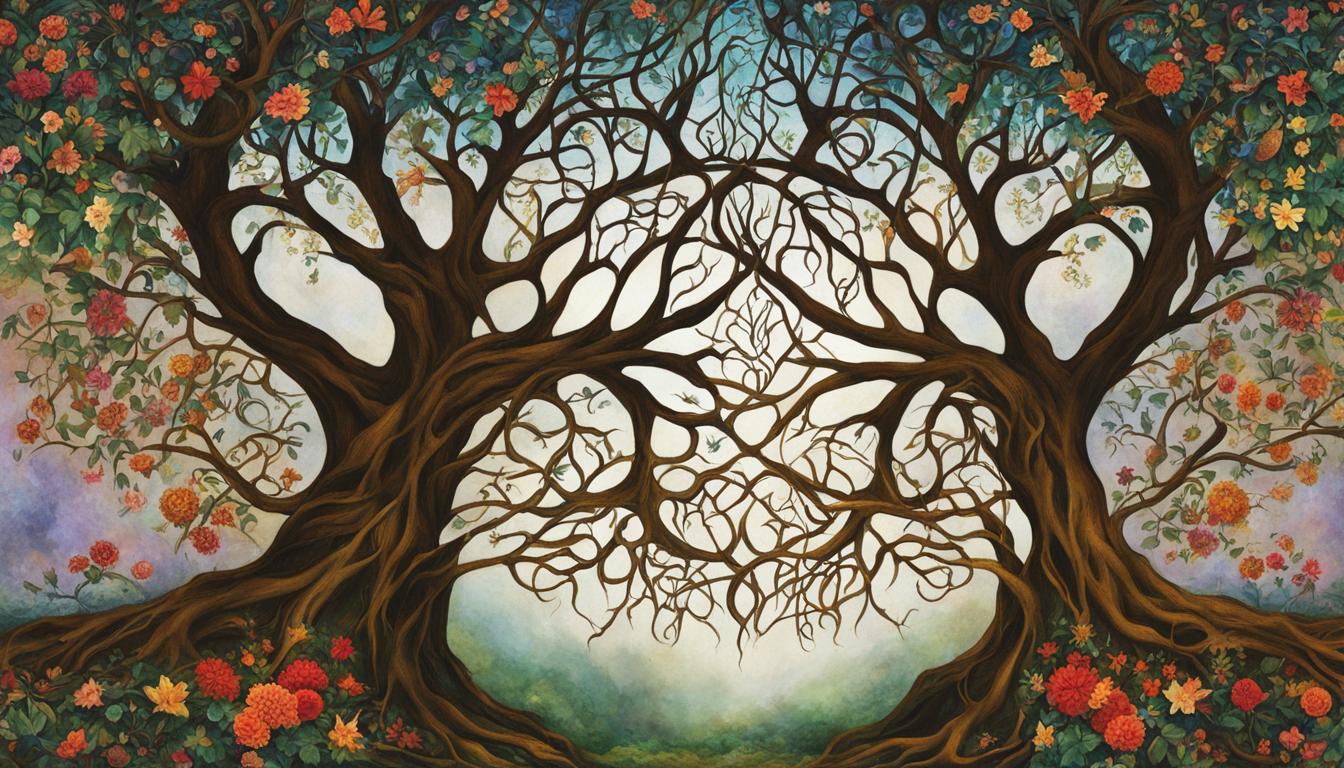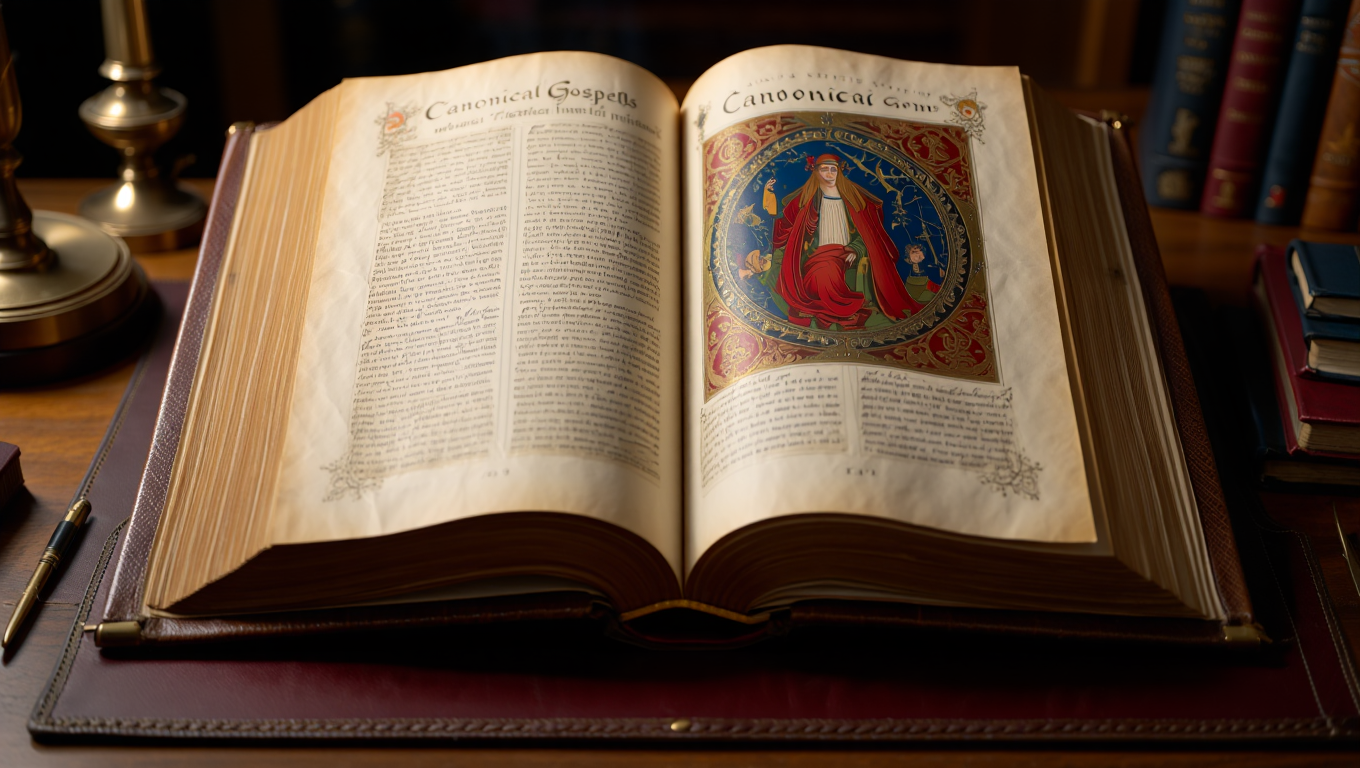The Book of Shadows and Wiccan Rede are two fundamental concepts within the Neopagan religion of Wicca. While both play significant roles in Wiccan practice, they serve different purposes and offer distinct guidance to practitioners.
Key Takeaways:
- The Book of Shadows is a religious text and instructional guide for magical rituals within the Neopagan religion of Wicca.
- The Wiccan Rede is a moral guideline that promotes ethical behavior and individual freedom.
- The Book of Shadows focuses on practical rituals and spells, while the Wiccan Rede emphasizes ethical decision-making.
- The Book of Shadows is a personal and sacred text for Wiccans, reflecting their spiritual journey and experiences.
- Understanding the differences between the Book of Shadows and Wiccan Rede is essential for those interested in exploring Wicca and its principles.
Origin and History of the Book of Shadows
The Book of Shadows has a fascinating origin and history within the practice of Wicca. It was first introduced by Gerald Gardner, often referred to as the “father of Wicca.” Gardner created the book in the 1950s and used it within his Bricket Wood coven. He claimed that the Book of Shadows contained ancient spells and rituals that had been passed down through a secret witchcraft tradition.
However, the true origins of the Book of Shadows have been a subject of debate. Some suggest that Gardner may have drawn inspiration from other occult sources when creating the book. Regardless of its precise origins, the Book of Shadows gained prominence within Gardnerian Wicca and has since been adopted by various Wiccan traditions.
Gerald Gardner: The Father of Wicca
Gerald Gardner is a central figure in the history of Wicca. Born in 1884, he developed an interest in esotericism and occult practices from an early age. In the 1950s, Gardner founded his own coven and became instrumental in bringing Wicca into the modern world.
Gardner’s contributions to Wicca include the creation of the Book of Shadows, the initiation rituals of the Wiccan tradition, and the establishment of key principles such as the Wiccan Rede. His dedication to promoting Wicca as a legitimate spiritual path helped pave the way for its recognition and acceptance by a wider audience.
The Book of Shadows remains an essential part of Wiccan practice, serving as a sacred text and guide for ritualistic and magical practices. Its origin and history, intertwined with the legacy of Gerald Gardner, continue to shape and influence the vibrant and diverse Wiccan community.
Detailed Notes: Purpose and Content of the Book of Shadows
The Book of Shadows serves as a personal journal and magical grimoire for Wiccans. It contains instructions for rituals, spells, and magical techniques. The content of the book may vary depending on the individual practitioner, but it often includes information on herbalism, divination, astrology, and other magical practices. The Book of Shadows is considered a deeply personal and sacred text for Wiccans, reflecting their own spiritual journey and experiences.
The purpose of the Book of Shadows is to provide Wiccans with a comprehensive guide to their craft. It serves as a repository of knowledge and wisdom, allowing practitioners to document their rituals, spells, and magical experiences. In addition to the practical instructions, the book may also contain personal reflections, prayers, and blessings, making it a deeply personal and meaningful artifact.
The content of the Book of Shadows is highly individualized, reflecting the unique path and experiences of each practitioner. Some may choose to include specific spells and rituals that resonate with them, while others may focus more on herbal remedies or divination techniques. The Book of Shadows is a living document, constantly evolving and adapting as the practitioner’s spiritual journey progresses.
| Contents of the Book of Shadows | Role of the Book of Shadows |
|---|---|
| – Ritual instructions | – Provides a practical guide for rituals and spells |
| – Spellcrafting techniques | – Serves as a repository of knowledge and wisdom |
| – Correspondences (herbs, colors, crystals, etc.) | – Allows practitioners to document their rituals and magical experiences |
| – Personal reflections and insights | – Reflects the practitioner’s unique spiritual journey |
| – Prayers, invocations, and blessings | – Acts as a personal and meaningful artifact |
Meaning and Importance of the Wiccan Rede
The Wiccan Rede is a fundamental moral guideline that holds significant importance in Wiccan practice. It serves as a moral compass, guiding Wiccans in their ethical decision-making and behavior. The phrase “An ye harm none, do what ye will” encapsulates the core principle of the Wiccan Rede, emphasizing the importance of avoiding harm to others while promoting personal freedom and responsibility.
Central to the Wiccan Rede is the idea of living in harmony with oneself, others, and the natural world. Wiccans strive to align their actions and intentions with love, respect, and compassion for all living beings. By following the Wiccan Rede, practitioners aim to create a positive and balanced energy that fosters personal growth, spiritual development, and interconnectedness with the universe.
The significance of the Wiccan Rede lies in its ability to foster a sense of responsibility and mindfulness in Wiccans. It encourages individuals to consider the consequences of their actions and make choices that promote harmony and well-being. By adhering to the principles of the Wiccan Rede, practitioners cultivate a strong sense of ethics and integrity, which guides them in all aspects of their lives.
Table: Key Aspects of the Wiccan Rede
| Aspect | Explanation |
|---|---|
| Non-harming | The Wiccan Rede promotes the idea of avoiding harm to oneself and others. It encourages practitioners to consider the consequences of their actions and make choices that uphold the well-being of all living beings. |
| Personal Freedom | The Wiccan Rede emphasizes individual freedom and responsibility. Wiccans are encouraged to embrace their personal power and make decisions that align with their own values and beliefs, as long as they do not cause harm to others. |
| Ethical Decision-making | The Wiccan Rede serves as a moral guideline for ethical decision-making. It prompts practitioners to reflect on the potential consequences of their choices and act in accordance with love, respect, and compassion. |
| Interconnectedness | The Wiccan Rede highlights the interconnectedness of all living beings and the natural world. By living in harmony with oneself, others, and the environment, practitioners seek to create a positive energy that promotes balance and spiritual growth. |
Relationship Between the Book of Shadows and Wiccan Rede
While the Book of Shadows and Wiccan Rede are distinct concepts within Wicca, they are interconnected in the practice of Wiccan spirituality. The Book of Shadows serves as a practical guide for rituals, spells, and magical techniques, providing Wiccans with the tools and knowledge to perform their craft. It contains instructions and information on various magical practices, such as herbalism, divination, and astrology. In this way, the Book of Shadows acts as a resource for implementing the ethical guidelines expressed in the Wiccan Rede.
The Wiccan Rede, on the other hand, is a moral guideline that emphasizes the principle of not causing harm to others. It encourages Wiccans to consider the consequences of their actions and make ethical decisions in alignment with the principles of love, harmony, and respect. The Wiccan Rede promotes personal freedom and responsibility, allowing individuals to exercise their will as long as it does not harm others.
Wiccans often consult their Book of Shadows when making decisions to ensure that their magical practices align with the ethical teachings of the Wiccan Rede. The Book of Shadows serves as a practical resource for implementing the guidelines of the Wiccan Rede into their daily lives. By combining the knowledge and techniques found in the Book of Shadows with the moral principles of the Wiccan Rede, Wiccans are able to practice their craft in an ethical and responsible manner.
| Book of Shadows | Wiccan Rede |
|---|---|
| Practical guide for rituals and spells | Moral guideline for ethical behavior |
| Contains instructions on magical practices | Emphasizes not causing harm to others |
| Provides tools and knowledge for the craft | Promotes personal freedom and responsibility |
Together, the Book of Shadows and Wiccan Rede form a cohesive framework for Wiccans to navigate their spiritual journey and practice their craft. The Book of Shadows serves as a practical resource, while the Wiccan Rede provides the ethical guidelines necessary for responsible magical practice. By combining these two elements, Wiccans are able to cultivate a sense of harmony, compassion, and respect in their spiritual path.

Different Versions of the Book of Shadows and Wiccan Rede
While the Book of Shadows and Wiccan Rede are fundamental elements of Wiccan practice, they are not fixed in their content and interpretation. There are various versions of the Book of Shadows, each reflecting the unique perspectives and experiences of different authors and practitioners. These alternate versions may include additional rituals, spells, and personal insights, allowing for a more diverse and expansive understanding of Wiccan practices.
Similarly, the Wiccan Rede may have different variants in wording and interpretation. While the core principle of “An ye harm none, do what ye will” remains constant, the specific language and nuances can vary among different Wiccans and traditions. The Wiccan Rede is open to individual interpretation, allowing practitioners to adapt it to their own moral compass and ethical decision-making.
While the foundational Book of Shadows was created by Gerald Gardner and Doreen Valiente, the alternate versions reflect the evolving nature of Wicca as a modern religion. They provide practitioners with a wealth of knowledge, perspectives, and magical practices to explore and incorporate into their own spiritual journeys. Likewise, the varied interpretations of the Wiccan Rede allow for a more inclusive and adaptable ethical framework within the Wiccan community.
| Book of Shadows | Wiccan Rede |
|---|---|
| Created by Gerald Gardner and Doreen Valiente, but with alternate versions by different authors and practitioners. | Core principle of “An ye harm none, do what ye will,” but with variations in wording and interpretation. |
| Contains instructions for rituals, spells, and magical techniques, with additional content depending on the practitioner. | Provides moral guidelines for ethical behavior, open to individual interpretation and application. |
| Reflects personal experiences and insights, allowing for a diverse understanding of magical practices. | Promotes personal freedom and responsibility, encouraging ethical decision-making. |
Overall, the existence of different versions of the Book of Shadows and variations of the Wiccan Rede underscores the flexibility and adaptability of Wiccan practices. It provides practitioners with the opportunity to explore different paths, rituals, and ethical frameworks, allowing for a more individualized and diverse expression of their spirituality.
Popularity and Cultural References of the Book of Shadows and Wiccan Rede
The Book of Shadows and Wiccan Rede have become increasingly popular and have found their way into mainstream culture. Their depictions in popular media have contributed to the heightened interest and curiosity surrounding these aspects of Wiccan practice.
One notable example is the American television series Charmed, which prominently features the Book of Shadows as a powerful tool utilized by the show’s main characters, who are witches. The book is depicted as a source of knowledge and spells, playing a significant role in their magical endeavors. This portrayal has not only introduced the concept of the Book of Shadows to a wider audience but has also added to its allure and mystique.
The Wiccan Rede, on the other hand, has been referenced in various books, movies, and music as a representation of Wiccan beliefs and ethics. Its central principle of “An ye harm none, do what ye will” has resonated with audiences seeking messages of love, harmony, and personal responsibility. The Wiccan Rede has been embraced by those who value its emphasis on ethical decision-making and respect for all living beings.
| Book of Shadows | Wiccan Rede |
|---|---|
| The Book of Shadows is featured in the television series Charmed as a powerful magical tool. | The Wiccan Rede has been referenced in various books, movies, and music, promoting its values of love and respect for all living beings. |
| It has gained recognition as an essential element of Wiccan practice. | The Wiccan Rede has contributed to the understanding and awareness of Wiccan beliefs and ethics. |
| Its portrayal in popular culture has added to its allure and mystique. | The Wiccan Rede’s core principle has resonated with individuals seeking guidance in making ethical choices. |
These cultural references and representations serve to ignite curiosity and create a sense of intrigue around the Book of Shadows and the Wiccan Rede. They contribute to a broader understanding of Wicca and its principles, exposing more people to these aspects of the religion. As a result, individuals may be inspired to explore Wiccan practices and incorporate them into their own spiritual journeys.
Conclusion
In conclusion, the Book of Shadows and Wiccan Rede play distinct roles within Wiccan practice. The Book of Shadows serves as a practical and personal guide for rituals, spells, and magical techniques. It is a valuable resource that Wiccans consult to deepen their understanding of magical practices. On the other hand, the Wiccan Rede provides a moral framework and ethical guidelines for Wiccans to live by.
The Wiccan Rede promotes the principles of non-harm and personal freedom, encouraging individuals to make ethical decisions and consider the consequences of their actions. By aligning with the Wiccan Rede, Wiccans strive to cultivate love, harmony, and respect for all living beings.
While the Book of Shadows and Wiccan Rede are separate entities, they are interconnected in Wiccan practice. Wiccans consult their Book of Shadows when performing magical rituals, ensuring that their actions align with the ethical guidelines expressed in the Wiccan Rede. This interplay between the Book of Shadows and Wiccan Rede allows Wiccans to integrate magical practices with ethical considerations, enriching their spiritual journeys.
Understanding the differences between the Book of Shadows and Wiccan Rede is essential for those interested in exploring Wicca. By recognizing the distinct roles and purposes of these aspects of Wiccan practice, individuals can gain a deeper understanding of the rich tradition and principles that guide the Wiccan path.
FAQ
What is the difference between the Book of Shadows and the Wiccan Rede?
The Book of Shadows is a religious text and instructional guide for magical rituals, while the Wiccan Rede is a moral guideline for ethical behavior.
Who created the Book of Shadows?
The Book of Shadows was introduced by Gerald Gardner, often referred to as the “father of Wicca.”
What does the Book of Shadows contain?
The Book of Shadows contains instructions for rituals, spells, and magical techniques, covering topics such as herbalism, divination, and astrology.
What is the meaning of the Wiccan Rede?
The Wiccan Rede promotes the idea of not causing harm to others and encourages individual freedom and responsibility.
How do the Book of Shadows and Wiccan Rede relate to each other?
The Book of Shadows provides the tools and knowledge for performing rituals and magic, which can be done in accordance with the ethical guidelines expressed in the Wiccan Rede.
Are there different versions of the Book of Shadows and Wiccan Rede?
Yes, there are alternate versions of the Book of Shadows written by different authors and practitioners, as well as variations in wording and interpretation of the Wiccan Rede.
Have the Book of Shadows and Wiccan Rede been referenced in popular culture?
Yes, the Book of Shadows has been featured in the television series Charmed, while the Wiccan Rede has been referenced in books, movies, and other media as a representation of Wiccan beliefs and ethics.
What is the summary of the differences between the Book of Shadows and Wiccan Rede?
The Book of Shadows serves as a practical guide for rituals and spells, while the Wiccan Rede provides moral guidelines for ethical behavior and decision-making.
 Skip to main content
Skip to main content


